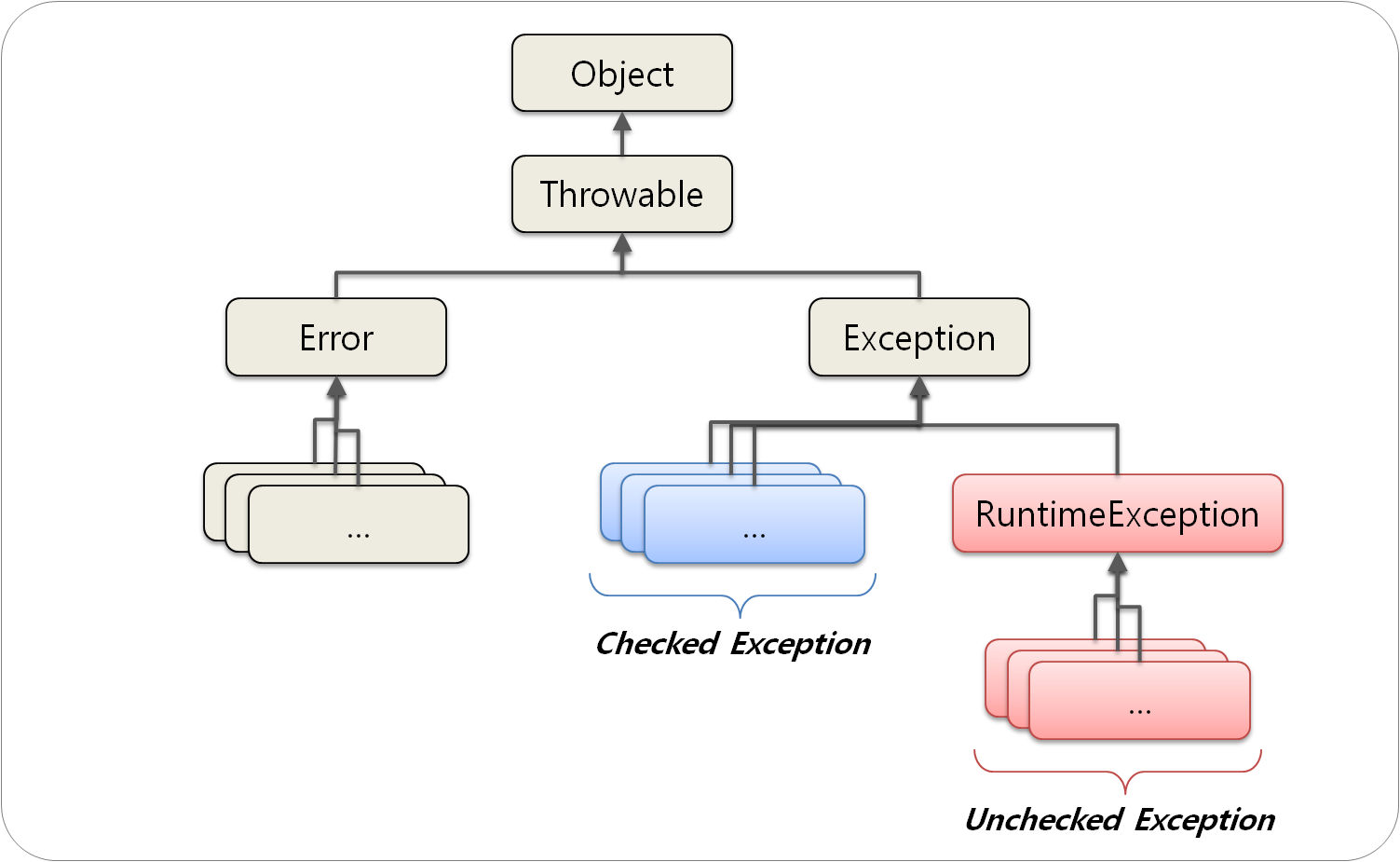https://velog.io/@yoonee1126/Day26-%EC%98%88%EC%99%B8%EC%B2%98%EB%A6%AC 보충
에러와 예외
에러
- 시스템레벨에서 발생. 프로그래머가 처리 불가
예외(Exception)
- 프로그래머에 의해 발생. 처리 가능
- 모든 예외는 Exception클래스의 자손

| 예외 | 설명 | 예외처리 | 예시 | 발생시점 |
|---|---|---|---|---|
| checked Exception | 외부영향으로 발생 | 필수 | IOException | 컴파일 시 |
| runtime Exception | 프로그래머 실수로 발생 | 필수 X | IndexOutOfBoundException, ArithmeticException | 실행 시 |
주요메서드
public static void nanum(int a, int b) throws ArithmeticException{
System.out.println(a/b);
}
public static void main(String[] args) {
int a,b;
a=100;
b=0;
try {
nanum(a,b);
} catch(ArithmeticException e) {
System.out.println(e.getMessage());
e.printStackTrace();
System.out.println(e.toString());
} finally {
System.out.println("무조건 실행되는 문장");
}
}printStackTrace()
- 예외 발생시의 메서드정보(근원지)와 예외메세지를 출력

getMessage()
- 예외 원인 출력

toString()
- 예외 내용과 원인 출력

try-catch
try {
// 예외가 발생할 가능성이 있는 문장
} catch(Exception e){
// Exception이 발생했을 때, 이를 처리하기 위한 문장
} catch(Exception2 e){
// Exception2가 발생했을 때, 이를 처리하기 위한 문장
}- 작성된 예외 중 일치하는 단 한개의 catch블럭만 수행됨
- 예외가 발생하지 않는 경우 try-catch문을 빠져나감
- try의 수행문 중간에 예외가 발생 할 경우, 하위 수행문은 실행되지 않음
try {
System.out.println(1);
System.out.println(0/10); // 예외 발생(ArithmeticException). catch문으로 이동
System.out.println(2); // 실행되지 않음
} catch(Exception e){ // ArithmeticException가 처리 될 수행문
System.out.println("예외발생");
}multi catch
- 여러 catch블럭을 하나로 합친 것
try{
...
}catch(Exception1 | Exception2 e){
e.printStackTrace();
}finally
try{
...
} catch(Exception c) {
...
} finally {
// 예외가 발생하던 안하던 실행 될 수행문
}- 예외 발생 여부와 상관없이 무조건 수행됨
- try-catch문의 가장 마지막에 위치해야함
throw
- 예외를 강제로 발생시킬 때 사용
- 프로그램 실행 전 프로그래머가 직접 예외를 발생 시킬 수 있음
public static void main(String args[]){
try{
throw new Exception("하이");
} catch (Exception e) {
System.out.println(e.getMessage());
}
}
// 출력값: 하이throws
public void example(int a) throws Exception{}- 해당 메서드에서 예외를 처리하지 않고, 자신을 호출한 메서드에 예외를 전달
- 호출한 메서드에서 예외처리를 하므로, 같은 예외여도 다른 처리가 가능
- 명시된 예외는 어디에선가 반드시 처리가 되어야 함
public void method1(){
int a,b;
a = 10;
b = 0;
try {
methodA(a,b);
}catch (ArithmeticException e){
System.out.println("처리방법1");
}
}
public void method2(){
int a,b;
a = 0;
b = 10;
try{
methodA(a,b);
} catch (ArithmeticException e){
System.out.println("처리방법2");
}
}
public static void methodA(int a, int b) throws ArithmeticException{
System.out.println(a/b);
}- 같은 예외(ArithmeticException)가 발생했지만 처리 결과는 다름
사용자정의 예외
- 프로그래머가 직접 예외 생성 가능
- 모든 예외의 부모클래스인 Exception 상속받아 사용
1. 예외정의
public class CustomException extends Exception{
CustomException(String message){
super(message); // 예외 객체 생성을 위한 Exception 생성자 호출
}
}
2. 예외발생
public class Example {
public static void main(String[] args){
try {
String name = "홍길동";
if(name=="홍길동"){
throw new CustomException("이미 존재하는 이름입니다.");
}
}catch (CustomException e) {
e.printStackTrace();
}
}
}1. 예외정의
public class CustomException extends Exception{
CustomException(String message){
super(message);
}
}
2. 예외발생
public class Example{
public static void main(String[] args) throws CustomException{
String name="홍길동";
if(name=="홍길동"){
throw new CustomException("이미 존재하는 이름입니다.");
}
}
}결론
- throw/throw를 사용하는 이유: 여러곳에서 발생한 예외를 한곳에서 처리하기 위함
참고
https://tedock.tistory.com/80
https://sundrystore.tistory.com/14
